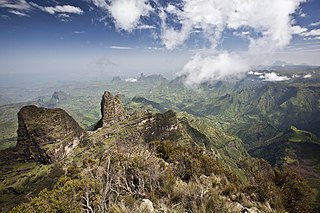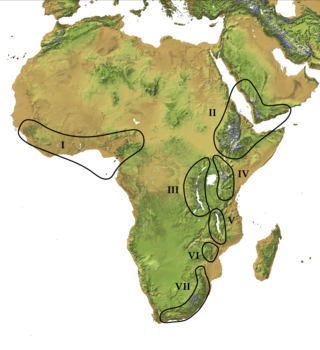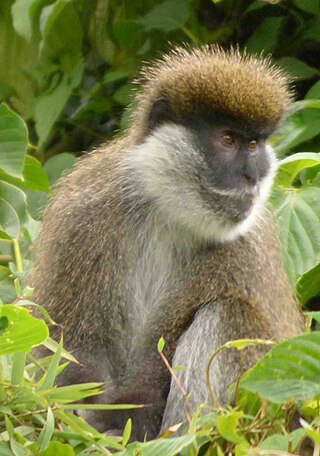
The Bale Mountains are mountain ranges in the Oromia Region of southeast Ethiopia, south of the Awash River, part of the Ethiopian Highlands. They include Tullu Demtu, the second-highest mountain in Ethiopia, and Mount Batu. The Weyib River, a tributary of the Jubba River, rises in these mountains east of Goba. The Bale Mountains National Park covers 2,200 square kilometers of these mountains. The park's main attractions are the wild alpine scenery and the relative ease with which visitors can see unique birds and mammals.

Bale Mountains National Park (BMNP) is a national park in Ethiopia. The park encompasses an area of approximately 2,150 km2 (830 sq mi) in the Bale Mountains and Sanetti Plateau of the Ethiopian Highlands.

The Ethiopian Highlands is a rugged mass of mountains in Ethiopia in Northeast Africa. It forms the largest continuous area of its elevation in the continent, with little of its surface falling below 1,500 m (4,900 ft), while the summits reach heights of up to 4,550 m (14,930 ft). It is sometimes called the "Roof of Africa" due to its height and large area. It is the only country in the region with such a high elevated surface. This elevated surface is bisected diagonally by the Great East African Rift System which extends from Syria to Mozambique across the East African Lakes. Most of the Ethiopian Highlands are part of central and northern Ethiopia, and its northernmost portion reaches into Eritrea.

The Afromontane regions are subregions of the Afrotropical realm, one of the Earth's eight biogeographic realms, covering the plant and animal species found in the mountains of Africa and the southern Arabian Peninsula. The Afromontane regions of Africa are discontinuous, separated from each other by lower-lying areas, and are sometimes referred to as the Afromontane archipelago, as their distribution is analogous to a series of sky islands.

The Southwestern Arabian montane woodlands is a xeric woodland ecoregion in the southwestern Arabian Peninsula.
Goba is a woreda in the Oromia Region, Ethiopia. It is named after the town of Goba. Part of the Bale Zone, Goba is bordered on the south by Mennana Harena Buluk, on the west by Mirab Arsi Zone, on the north by the Mena River which separates it from Sinanana Dinsho, and on the southeast by Berbere.
Delo Menna is one of the woredas in the Oromia Region of Ethiopia. It was part of former Menna Angetu woreda what was separated into Delo Menna and Harena Buluk woredas, and it's part of the Bale Zone. Delo Menna is bordered on the south by Meda Welabu, on the west and northwest by Harena Buluk, on the north by Goba, on the northeast by Berbere, and on the east by Guradamole. The administrative center of this woreda is Menna
Meda Welabu is a woreda in Oromia Region, Ethiopia. Part of the Bale Zone, Meda Welabu is bordered on the south by the Ganale Dorya River which separates it from the Guji Zone, on the northwest by West Arsi Zone, on the north by Mennana Harena Buluk, and on the northeast by Guradamole. The administrative center of the woreda is Bidire; other towns in Meda Welabu include Oborso.
Berbere is a woreda in Oromia Region, Ethiopia. Part of the Bale Zone, Berbere is bordered on the south by Mennana Harena Buluk, on the northwest by Goba, on the north by Sinanana Dinsho, on the northeast by Goro, and on the east by Guradamole; the Mena River separates it from Shinanana Dinsho and Goro. The administrative center of the woreda is Haro Dumal.
Guradamole is one of the woredas in the Somali Region of Ethiopia. Part of the Liben Zone, Guradamole is bordered on the south by the Ganale Dorya River which separates it from the Liben Zone, on the southwest by Meda Welabu, on the west by Mennana Harena Buluk, on the northwest by Berbere, on the northeast by the Mena River and on the southeast by the Somali Region. The administrative center of the woreda is Liben Zone.

The Bale Mountains vervet is a terrestrial Old World monkey endemic to Ethiopia, found in the bamboo forests of the Bale Mountains. All species in Chlorocebus were formerly in the genus Cercopithecus. The Bale Mountains vervet is one of the least-known primates in Africa. They avoid tree-dominated and bushland areas as their habitat. These monkeys mainly reside in the bamboo forest of the Bale Mountains due their dietary specialization on bamboo, but other factors, such as climate, forest history, soil quality, and disease, are likely to play a role in their choice to inhabit this area. The Bale Mountains vervet have a very quiet behavior and tend to flee when encountering a human being. It is also known as the Bale monkey and Bale Mountain grivet.

The Sanetti Plateau is a major plateau of the Ethiopian Highlands, in the Oromia Region of Ethiopia. The plateau is the highest part of the Bale Mountains, and is located within Bale Mountains National Park.
The Ethiopian montane grasslands and woodlands is a montane grasslands and shrublands ecoregion in Ethiopia. It occupies the middle elevations of the Ethiopian Highlands, between the high-elevation Ethiopian montane moorlands and lowland woodlands, savannas, shrublands, and thickets.

The Ethiopian montane moorlands is a montane grasslands and shrublands ecoregion in Ethiopia. It lies above 3,000 meters elevation in the Ethiopian Highlands, the largest Afroalpine region in Africa. The montane moorlands lie above the tree line, and consist of grassland and moorland with abundant herbs and shrubs adapted to the high elevation conditions.
Tullu Dimtu is the fourth highest peak in Ethiopia after Ras Dashen (4550m), Ancua (4462m), and Kidus Yared (4453m).
Harena Buluk is one of the woredas in the Oromia Region of Ethiopia. It was part of former Menna Angetu woreda. It is part of the Bale Zone. Harena Buluk woreda is bordered on the south by Meda Welabu, on the north by Goba, on the west by Nensebo, on the northwest by Adaba, and on the east by [[Delo Menna, Oromia (woreda). The administrative center for the woreda is Angetu.

The Ethiopian montane forests is a tropical moist broadleaf forest ecoregion in Ethiopia. It covers the southwestern and southeastern portions of the Ethiopian Highlands. The ecoregion includes distinctive Afromontane evergreen forests. The ecoregion's biodiversity is threatened by deforestation, conversion to agriculture, and overgrazing.
Ntchisi Mountain is a mountain in central Malawi. It is located in Ntchisi District, east of the town of Ntchisi.
The Rubeho Mountains are a mountain range in central Tanzania. The mountains in Dodoma and Morogoro regions, southeast of Tanzania's capital Dodoma. The Rubeho Mountains are part of the Eastern Arc Mountains, and are home to a biodiverse community of flora and fauna with large numbers of endemic species.
Arsi Mountains National Park is a national park in Arsi Zone of Oromia Region in Ethiopia. It protects a portion of the Ethiopian Highlands, and includes montane forests, subalpine heath, and alpine grasslands and shrublands. The park was designated in 2011, and covers an area of 10876 km2.










